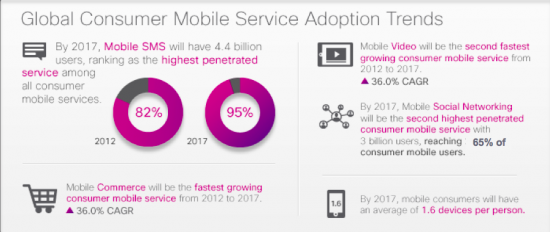































When was the last time you looked at your mobile device? Minutes ago? Seconds ago? We can't seem to live without them, and in the consumer space, new mobile services are popping up it seems faster than your Twitter feed can handle. Below are mobile consumer services trends from the latest VNI Service Adoption Forecast (2012 -2017) -you can see Mobile SMS, Mobile Commerce, Mobile Video, and Mobile Social Networking are on the rise, as is the number of devices per consumer.

Many organizations are looking for ways to leverage this upward trend in mobility and innovative mobile services for business benefit -whether it be for increasing customer satisfaction and communicating how the general population wants to receive communication, or offering Wi-Fi so users are able to consume the mobile services they want.
Cisco has made a big investment in mobile location-based services (LBS) over the past year with the introduction of the Connected Mobile Experiences (CMX) solution. CMX enables mobile users to adopt new innovative mobile services with an added benefit of relevance. Businesses can conduct mobile commerce, send texts, extend mobile video, or integrate mobile services with social media now based on the user's location. This enables you to deliver information, based on where the user is, similar to how we get information local to us when searching on a basic search engine on our laptops -it's the right content at the right time. And businesses know this is important -according to the business services overview from VNI Service Adoption Forecast above, business mobile LBS is the fastest-growing business mobile service at 32.9% CAGR.
When you think about how to apply location-based services to reach end users and consumers, IT has to consider the solution that enables the ability to adapt to a dynamic mobile application requirements while scaling to more and more devices coming onto the network.
Cisco's CMX solution provides an architectural approach to LBS, built on the leading wireless network as a foundation with services and applications running on top. Here are a few highlights:
This flexible architecture enables organizations to adapt to changing trends and meet consumers where they're at. For more detail on the CMX architecture and how your organization can benefit from it, read our latest white paper.
 Tags quentes :
Inovação
application
devices
consumer
architectural approach
ecommerce
customer satisfaction
Lbs
line-of-business
Tags quentes :
Inovação
application
devices
consumer
architectural approach
ecommerce
customer satisfaction
Lbs
line-of-business